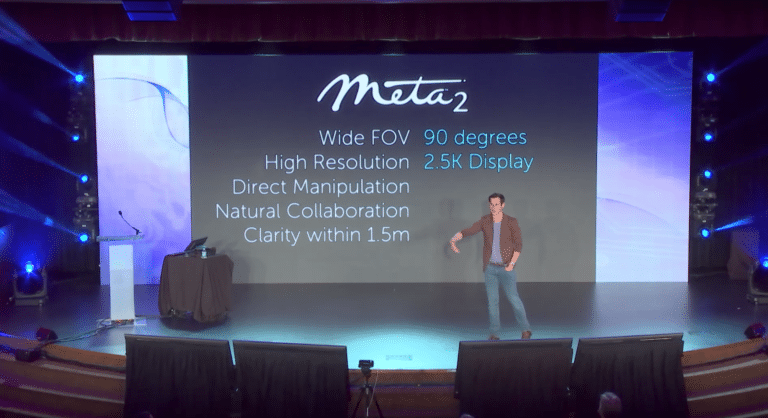
What are the biggest challenges in starting and growing an AR business? Some are technical of course, in blazing paths in a new field. But for the same reasons, lots of challenges are marketing and operational.
This was the topic of Meta founder and CEO Meron Gribetz’ address at AWE ’17. Embedded in full below, it’s part learnings from the field, and part demos and new announcements.
Going back to the Kickstarter for the Meta 1 dev kit, Gribetz says one challenge was to convince animators to contribute to the project with zero budget and notoriety. But the hardest part he says: getting a good endorsement.
“It was like going through a Jewish conversion process,” said Gribetz. “You have to get three ‘no’s’ before you get a ‘yes’.” Eventually the company got the golden endorsement: Columbia computer science professor Steve Feiner.
Then the Kickstarter orders started rolling in from the likes of Toyota, major construction companies and Steve Wozniak. These orders were an early indication of what we now know: AR will have a big home in enterprise.
“From that point on, it was all about what our customers taught us,” said Gribetz. We thought it would be 50 percent entertainment and 50 percent productivity. It was more like 80 percent productivity.”
Other important learnings from this period: Customers wanted immersion and photorealism (especially in medical uses). They wanted direct manipulation instead of gestures from afar. And they wanted it to be collaborative and clear at close distances.
So Meta got to work on those main points by assembling 130 hardware and software engineers. And its proud to say that it hit all marks, and that’s where it is now. Moving forward is about improving each of these factors.
Another lesson: Taking the time to get it right yielded results, said Gribetz. And the hardest part wasn’t the hardware but the software and UI. It didn’t want to shoehorn an existing OS but rather build something from the ground up.
To do so, it recruited our friend Stefano Baldassi and others from the Stanford Neuroscience department. This was a key move as the goal was to build an entirely new OS, natural and intuitive from a neuroscience standpoint.
“The user interface paradigm is what we obsessed about all these months and years,” said Gribetz, leading up to the unveiling of Airgrab, a new feature that lets you grab objects and manipulate them in x,y & z dimensions.
Gribitz also showed off Meta Workspace — a virtual desktop environment that utilizes the entire 360 space around a given user. That preceded other graphically-rich demos such as a 3D interactive MRI scan.
But these are better seen than read…the entire video is below. And a bonus video is the original Kickstarter campaign. Enjoy.
For a deeper dive on AR & VR insights, see ARtillry’s new intelligence subscription, and sign up for the free ARtillry Weekly newsletter.
Disclosure: ARtillry has no financial stake in the companies mentioned in this article, nor received payment for its production. Disclosure and ethics policy can be seen here.
Header image credit: YouTube
